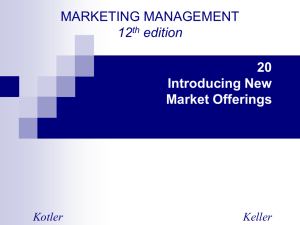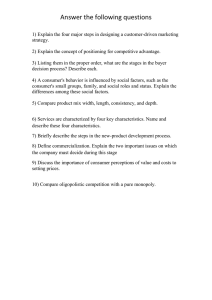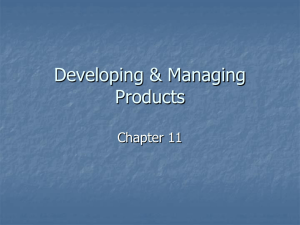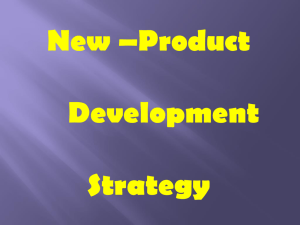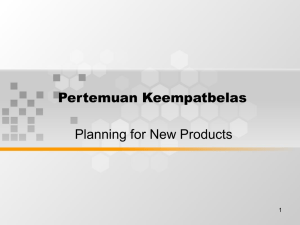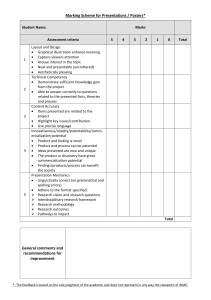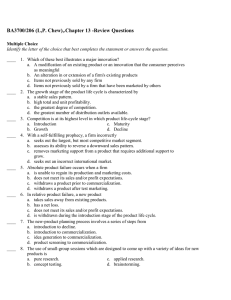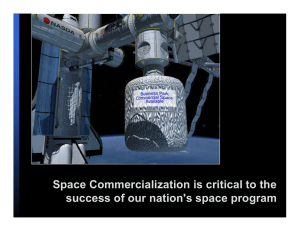Developing-New-Market-Offerings
advertisement
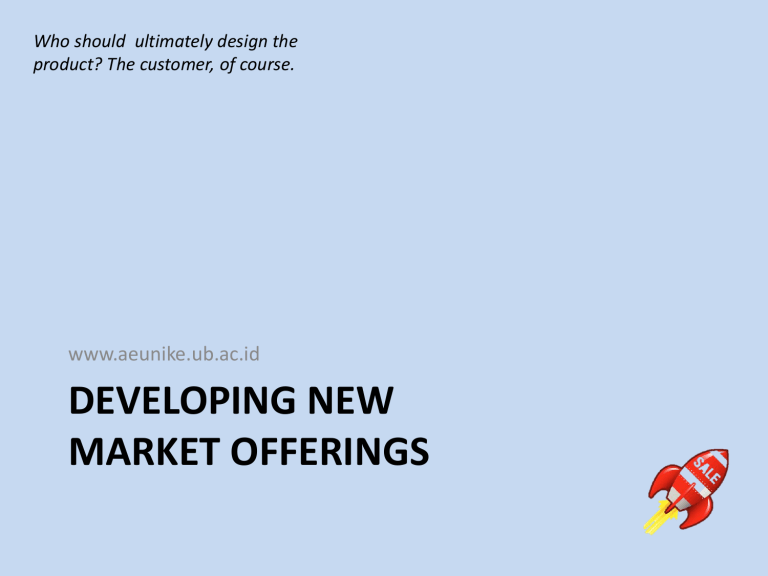
Who should ultimately design the product? The customer, of course. www.aeunike.ub.ac.id DEVELOPING NEW MARKET OFFERINGS Developing New Market Offerings Six categories of new products 1. 2. 3. 4. 5. 6. New-to-the-world products New product lines Additions to existing product lines Improvements and revisions of existing products Repositioning Cost reductions Challenges in New-Product Development New-Product Failure • Shortage of important ideas in certain areas • Fragmented markets • Social and governmental constraints • Cost of development • Capital shortages • Faster required development time • Shorter product life cycles Organizational Arrangements New-product deployment requires specific criteria • The product can be introduced within five years • The product has a market potential of at least $50 million and a 15 percent growth rate. • The product would provide at least 30 percent return on sales and 40 percent on investment. • The product would achieve technical or market leadership. Organizational Arrangements Organizing New-Product Development • Product managers • New-product managers • High-level management committee • New product department • Venture teams Managing the Development Process: Ideas Idea Generation • Interacting with Others – Sales representatives – Intermediaries – Product champion • Techniques for stimulating creativity in individuals and groups – – – – Attribute listing Forced relationships Morphological analysis Reverse assumption analysis – New contexts – Mind-mappinh Managing the Development Process: Ideas Idea Screening • Two types of errors in screening ideas – DROP-error – GO-error • Absolute product failure • Partial product failure • Relative product failure Managing the Development Process: Concept to Strategy Concept Development and Testing – Product idea – Product concept • Concept development – Category concept – Product-positioning map – Brand concept • Concept Testing – Rapid prototyping – Virtual reality – Customer-driven engineering Managing the Development Process: Concept to Strategy Concept Development and Testing • Questions to measure product dimensions – Communicability and believability – Need level – Gap level – Perceived value – Purchase intention – User targets, purchase occasions, purchasing frequency • Conjoint Analysis – Example: five design elements • • • • Three package designs Three brand names Three prices Possible Good Housekeeping seal • Possible money-back guarantee Managing the Development Process: Concept to Strategy • Marketing Strategy • Business Analysis – Estimating Total Sales • Survival-age distribution – Estimating Cost and Profits • Break-even analysis • Risk analysis Managing The Development Process: Development to Commercialization Product Development • Quality Function Deployment (QFD) • Customer attributes (CAs) • Engineering attributes (EAs) • Customer tests • Alpha testing • Beta testing • Consumer preference measures – Rank-order – Paired-comparison – Monadic-rating Managing The Development Process: Development to Commercialization Market Testing • Consumer-Goods Market Testing – Seeks to estimate four variables • • • • Trial First repeat Adoption Purchase frequency – Sales wave research – Simulated Test Marketing – Controlled Test Marketing – Test Markets • • • • • How many test cities? Which cities? Length of test? What information? What action to take? • Business-Goods Market Testing Managing The Development Process: Development to Commercialization Commercialization • When (Timing) 1. 2. 3. First entry Parallel entry Late entry • Where (Geographic Strategy) • To Whom (Target-Market Prospects) • How (Introductory Market Strategy) – Critical path scheduling (CPS) • Adoption – Consumer-adoption process – Consumer-loyalty process – Mass-market approach – Heavy-usage target marketing Managing The Development Process: Development to Commercialization Stages in the Adoption Process • Adopters of new products move through five stages – – – – – Awareness Interest Evaluation Trial Adoption Managing The Development Process: Development to Commercialization Factors Influencing the Adoption Process • Readiness to Try New Products and Personal Influence – Personal Influence • Characteristics of the Innovation – – – – – Relative advantage Compatibility Complexity Divisibility Communicability • Organizations’ Readiness to Adopt Innovations Adopter Categorization on the Basis of Relative Time of Adoption of Innovation Reference • Kotler, Philip, and Kevin Keller. Marketing Management. 13th ed. Prentice Hall, 2008.

